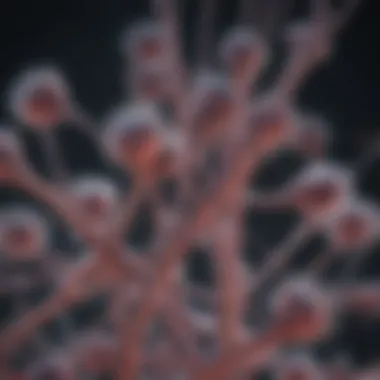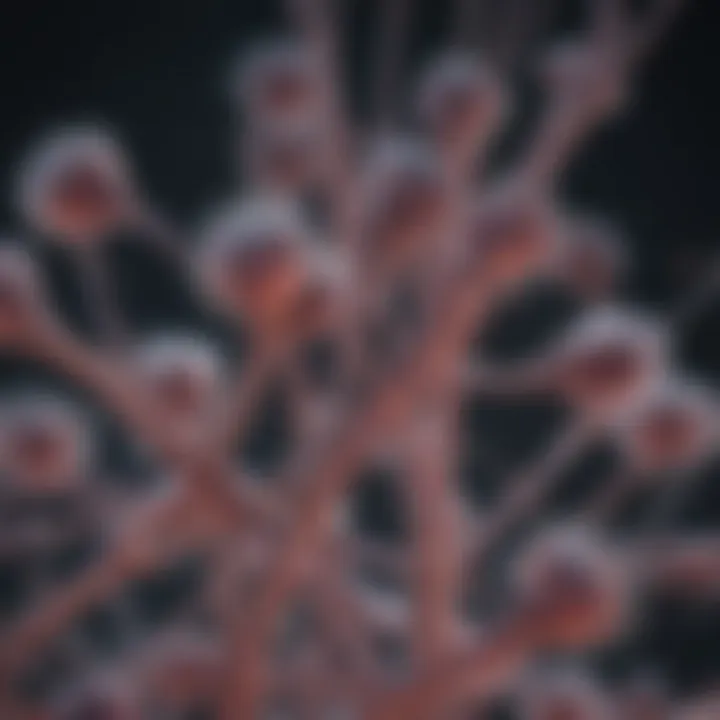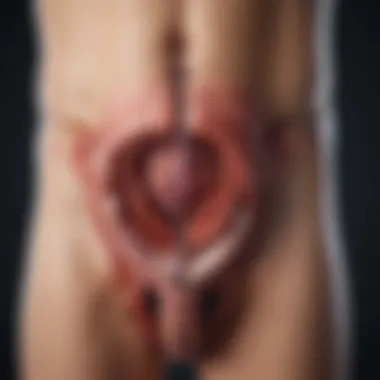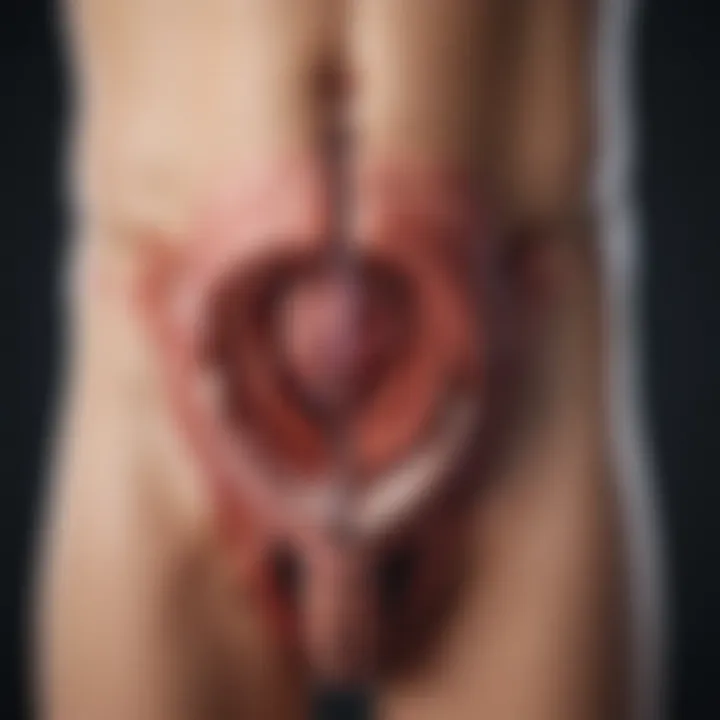Gram Negative Rods in UTIs: Treatment Insights


Intro
Urinary tract infections (UTIs) are prevalent and often complex medical conditions, especially when caused by gram-negative rods. These bacteria, including Escherichia coli, Klebsiella pneumoniae, and Pseudomonas aeruginosa, have become significant contributors to UTI cases. The challenge in treating these infections stems from their unique structural characteristics, which often lead to antibiotic resistance. As healthcare providers increasingly encounter cases that do not respond to standard treatment, understanding the nuances of treatment approaches becomes crucial.
The emergence of antibiotic resistance is a pressing issue. Gram-negative rods possess mechanisms that confer resistance to many commonly used antibiotics, complicating therapeutic options. This article provides an evidence-based methodology for diagnosing and treating UTIs caused by these bacteria, focusing on various treatment strategies, resistance patterns, and the latest clinical guidelines. By synthesizing findings from recent research, we aim to equip healthcare professionals with the knowledge needed to enhance patient care in the face of evolving challenges.
Key Findings
Major Results
- Prevalence of Antibiotic Resistance: Recent studies demonstrate that resistance rates among gram-negative rods are increasing. For instance, it has been observed that approximately 30% of E. coli strains are now resistant to first-line antibiotics such as nitrofurantoin.
- Alternative Treatment Approaches: Options such as trimethoprim-sulfamethoxazole, fosfomycin, and certain carbapenems have shown efficacy in treatment but require careful consideration based on local resistance patterns.
- Diagnostic Advancements: Implementing rapid diagnostic tests can significantly improve treatment outcomes. These tests help identify the specific pathogen and its susceptibility profile early in the treatment process.
Discussion of Findings
The increasing resistance among gram-negative rods requires a multifaceted approach to treatment. It is paramount for clinicians to not only rely on antibiotic selection but also consider factors like patient history, local resistance data, and current clinical guidelines. Personalized treatment plans based on microbial sensitivities can lead to better patient outcomes.
"Understanding the characteristics of gram-negative rods and emerging resistance is critical for effective UTI management."
The evidence also highlights the need for clinicians to remain vigilant and to update their knowledge regarding current resistance trends. Regular review of local antibiograms and adherence to best practice guidelines is essential.
Methodology
Research Design
A comprehensive literature review has been conducted to analyze the existing body of research related to gram-negative rods in urinary tract infections. The review includes peer-reviewed journals, clinical guidelines, and recent studies focusing on treatment efficacy and resistance patterns.
Data Collection Methods
Data was collected using:
- Clinical Trials: Analysis of recent clinical trials focusing on antibiotic efficacy against gram-negative rods.
- Surveillance Reports: Reviewing local and regional antimicrobial resistance reports to understand trends and resistance mechanisms among pathogens.
- Health Records: Retrospective examination of patient records to assess outcomes based on various treatment regimens in cases of UTIs caused by gram-negative bacteria.
This structured approach enables the synthesis of relevant information, helping to formulate effective treatment strategies to combat UTIs caused by gram-negative rods.
Understanding Gram-Negative Rods
Understanding gram-negative rods is vital in the context of urinary tract infections (UTIs). The clinical implications of these bacteria extend well beyond basic microbiology, influencing diagnostics and treatment choices significantly. Knowing their characteristics aids in identifying the causative agents of UTIs and choosing appropriate antibiotic therapies. Gram-negative rods possess a unique cell wall structure, which not only affects their own viability but also plays a crucial role in resistance development against antibiotics.
The interplay between antibiotic treatment and the behavior of gram-negative rods must be acknowledged by healthcare professionals. It shapes the clinical outcomes of UTI management, thereby making it crucial for patient care. In particular, understanding the common isolates can guide effective therapeutic approaches and improve patient outcomes.
Classification and Characteristics
Gram-negative rods (GNRs) are classified under the domain Bacteria and are distinct due to their cell wall structure, which comprises a thin peptidoglycan layer and an outer membrane containing lipopolysaccharides. This complexity contributes to a variety of biochemical attributes that affect how these organisms interact with their environment, including their resistance to certain antibiotics.
The classification includes families such as Enterobacteriaceae, Pseudomonadaceae, and Vibrionaceae, among others. Each family consists of various genera and species relevant to URIs. Their identification and classification are significant, given that some are more pathogenic than others in specific contexts, particularly in urinary tract infections.
Common Isolates in UTIs
Several gram-negative rods are frequently isolated from urinary tract infections. They typically include:
Escherichia coli
Escherichia coli is the predominant cause of UTIs, accounting for nearly 80% of cases. It thrives in the intestinal tract but can enter the urogenital area causing infections. Its virulence factors—like adhesins and toxins—enhance its ability to colonize the urinary tract. As a result, the relevance of E. coli in the subject of UTIs cannot be overstated. Its significance derives from its ubiquity and adaptability, making it a central focus in understanding the treatment for GNR-related UTIs. However, some strains of E. coli are resistant to various antibiotics, particularly due to plasmid acquisition, complicating treatment protocols.
Klebsiella pneumoniae
Klebsiella pneumoniae is another gram-negative rod implicated in UTIs, especially in patients with underlying conditions. It is known for its polysaccharide capsule that provides protection against phagocytosis. This organism’s resistance mechanisms are noteworthy, making it a source of concern in the treatment landscape. Clinicians often face challenges with Klebsiella due to its emerging resistance patterns, especially Extended-Spectrum Beta-Lactamases (ESBLs).
Proteus mirabilis


Proteus mirabilis is characterized by its ability to produce urease, leading to alkaline urine and facilitating the formation of struvite stones. Its role in UTIs is significant, especially in complicated cases. Proteus is less common than E. coli but often presents in cases associated with urinary catheterization or anatomical abnormalities. Its unique feature of swift motility helps it ascend the urinary tract, making treatment more complex.
Enterobacter spp.
Enterobacter species are increasingly recognized in nosocomial infections and UTIs. Their biochemical versatility allows them to exploit diverse environments. However, they are often resistant to common antibiotics, presenting a challenge in therapeutic decisions. Understanding their profile and pathogenicity is essential in tailor-making treatment strategies for affected patients.
Pathogenesis of UTIs
The pathogenesis of urinary tract infections caused by gram-negative rods entail a multifaceted interaction between the bacteria and the host's genitourinary system. Adherence to the uroepithelial cells is critical for colonization, and this is mediated by pili and fimbriae present on the bacterial surface. Following adherence, the release of toxins and enzymes leads to inflammatory responses, exacerbating the clinical symptoms associated with UTIs.
Individual factors such as host immune responses, anatomical abnormalities, and the presence of foreign bodies like catheters further complicate the infection landscape. A thorough understanding of this pathogenesis is necessary for rhe health professionnals as it guides the preventive and therapeutic interventions required to manage UTIs effectively.
Diagnosis of Gram-Negative Rod UTIs
Diagnosis of urinary tract infections caused by gram-negative rods is a crucial process that influences treatment decisions and patient outcomes. Understanding the nuances of diagnosing these infections ensures that clinicians choose the most effective therapeutic approaches. Early and accurate diagnosis not only helps to alleviate the patient's symptoms but also prevents the complications associated with untreated infections.
The diagnosis typically incorporates clinical evaluations, laboratory tests, and careful interpretation of the results. Recognizing the clinical presentation, conducting appropriate laboratory tests, and correctly interpreting results are essential elements in accurately diagnosing UTIs caused by these organisms. Each aspect of diagnosis can lead to more effective treatment and better patient management.
Clinical Presentation
The clinical presentation of a UTI primarily includes symptoms such as dysuria, frequency, and urgency of urination. Patients may also experience lower abdominal pain and fever, which can indicate more severe infection. It is common for these symptoms to overlap with those caused by other conditions, which makes accurate assessment important. Given that the symptoms might vary in severity, it is essential for healthcare providers to perform thorough patient histories and physical examinations. This step aids in distinguishing between simple and complicated UTIs, thus influencing the choice of treatment quickly.
Laboratory Tests
Laboratory tests play a critical role in confirming the diagnosis of gram-negative rod UTIs. They provide objective evidence of infection and guide subsequent treatment decisions.
Urine Culture
Urine culture remains the gold standard in diagnosing urinary tract infections. This test identifies the presence of bacteria in the urine. A key characteristic of urine culture is its ability to determine the specific bacterial species responsible for the infection. This information is crucial because effective treatment hinges on understanding the causative organism.
The unique feature of urine culture lies in its sensitivity and specificity. It can isolate even low numbers of bacteria, which makes it an advantageous tool in diagnosing UTIs. However, the time it takes to obtain results (usually 24 to 48 hours) may delay treatment initiation, which is a disadvantage for patients requiring immediate intervention.
Antibiotic Sensitivity Testing
Antibiotic sensitivity testing is critical for identifying the most effective antibiotics against the isolated strain. This test analyzes how well the identified bacteria respond to various antibiotics, which assists healthcare providers in tailoring treatment options. A key characteristic of this testing is its ability to help counteract antibiotic resistance, a growing concern in UTI management.
The unique feature of sensitivity testing is that it provides real-time information on the antimicrobial efficacy of antibiotics, highlighting resistant strains and guiding appropriate therapy. However, a disadvantage may include the time required to conduct the test, potentially delaying adequate treatment.
Imaging Studies
Imaging studies like ultrasound or CT scans are occasionally necessary, especially in complicated UTIs. They help visualize structural abnormalities, kidney involvement, or obstructions that may exacerbate infection. The key characteristic of imaging is its ability to assess the urinary tract's anatomy, therefore guiding further management.
The unique advantages of imaging studies are their non-invasive nature and capacity to provide detailed insights into the urinary system. However, they also have disadvantages, including potential exposure to radiation and the need for additional resources and time.
Interpretation of Results
Interpreting laboratory results requires a skilled eye and a strong understanding of clinical context. Clinicians must consider factors such as the patient's symptoms, history, and laboratory findings together. A thoughtful interpretation can lead to effective treatment strategies that are tailored to individual patient needs, ultimately enhancing care and outcomes for patients suffering from UTIs.
Treatment Strategies for UTI Caused by Gram-Negative Rods
The treatment strategies for urinary tract infections (UTIs) caused by gram-negative rods are essential for effective patient management. Considering the increasing incidence of these infections and the associated complications, choosing appropriate treatment regimens is critical. This section emphasizes the importance of understanding available antibiotic options, making informed decisions based on patient history, and establishing correct treatment duration.
Antibiotic Options
When it comes to UTIs caused by gram-negative rods, it is crucial to select the right antibiotic. The choice depends on the bacteria involved and their susceptibility patterns. Below are the details of different antibiotic classes commonly used in this context.
Beta-Lactams
Beta-lactams are widely used for treating UTIs due to their effectiveness against a range of gram-negative bacteria. Their key characteristic is the beta-lactam ring that interferes with cell wall synthesis. This makes them beneficial because they can effectively target many pathogens responsible for UTIs. A notable feature is the varied pharmacokinetic profiles across different beta-lactam agents, which can be advantageous in tailoring treatment to specific patient needs. However, resistance can limit their efficacy.
Fluoroquinolones


Fluoroquinolones are another popular choice, recognized for their broad-spectrum activity against gram-negative rods. A standout characteristic is their mechanism of action, which inhibits DNA gyrase, thus preventing bacterial replication. This is especially beneficial in cases where resistance to other classes arises. However, there are concerns regarding potential adverse effects, particularly on musculoskeletal health in younger patients, which warrant careful consideration in selecting these agents.
Tetracyclines
Tetracyclines offer a different approach to treating UTIs. Their key attribute is their ability to inhibit protein synthesis by binding to the bacterial ribosome. This makes them effective against certain gram-negative pathogens. They are particularly valuable in cases where alternative treatments are not suitable. Nonetheless, tetracyclines have limitations, including issues with absorption and potential staining of teeth, especially in pediatric populations.
Aminoglycosides
Aminoglycosides are powerful antibiotics with a unique mechanism that also targets protein synthesis. Their key characteristic is rapid bactericidal activity, making them effective against serious UTIs. Aminoglycosides are often reserved for severe infections, particularly when there is risk of multi-drug resistance. However, they require careful monitoring due to potentially serious side effects, including nephrotoxicity and ototoxicity.
Trimethoprim-Sulfamethoxazole
Trimethoprim-sulfamethoxazole is a combination antibiotic that effectively targets a broad range of pathogens causing UTIs. Its key feature is the synergistic effect of both components, which results in enhanced therapeutic efficacy. This option is particularly well-suited for uncomplicated UTIs. However, resistance issues have been increasingly reported, which can limit its effectiveness in some areas.
Considerations for Choosing Antibiotics
When selecting antibiotics, several considerations must be taken into account to optimize treatment outcomes.
Severity of Infection
Severity of infection is a fundamental factor for guiding treatment. In mild cases, outpatient management may suffice, while severe or complicated UTIs may necessitate hospitalization and intravenous antibiotics. This distinction is beneficial as it allows for a more targeted and effective approach to patient care. Treatment guidelines often vary based on infection severity, so a careful evaluation is necessary.
Patient History
Patient history plays a vital role in antibiotic selection. Factors such as previous infections, comorbidities, and current medications influence the choice of therapy. Understanding a patient’s unique history helps in avoiding drugs that may cause adverse interactions or have a history of resistance. This individualized approach to treatment contributes significantly to enhancing patient safety and effectiveness.
Resistance Patterns
Resistance patterns are increasingly essential in guiding antibiotic choices. Local resistance data informs clinicians about prevalent strains and their susceptibility profiles. This is beneficial in tailoring therapy to ensure it is effective against the specific pathogen involved in the infection. Awareness of resistance trends thus can significantly influence treatment success.
Duration of Treatment
The duration of antibiotic therapy is another critical aspect of managing UTIs effectively.
Guidelines for Different Patient Groups
Treatment guidelines may differ based on patient demographics and health status. For example, uncomplicated UTIs in healthy adults may require a shorter duration compared to recurrent infections or those in patients with underlying conditions. Understanding these guidelines allows clinicians to optimize treatment duration, balancing efficacy with the potential for developing resistance.
Adherence to tailored treatment strategies is crucial in managing UTIs. Monitoring resistance and adjusting therapies provide a framework for effective patient care.
Antibiotic Resistance in Gram-Negative Rods
Antibiotic resistance in gram-negative rods is a significant concern in the treatment of urinary tract infections (UTIs). This phenomenon not only complicates treatment but also poses a risk to patient health and safety. As gram-negative rods often exhibit a range of resistance mechanisms, understanding these can guide clinicians in choosing effective therapies. The increasing prevalence of antibiotic-resistant strains necessitates a strategic approach to treatment, making this topic essential in contemporary healthcare discussions.
Overview of Resistance Mechanisms
Resistance mechanisms in gram-negative rods include several complex biological processes. These bacteria can produce enzymes such as beta-lactamases which can inactivate many commonly used antibiotics. Additionally, some gram-negative organisms can modify their cell wall permeability, preventing drugs from entering the cell. Efflux pumps are another adaptation that allows these bacteria to pump out antibiotics before they can exert their effects. This multifaceted approach makes treating infections caused by gram-negative rods very challenging, especially in individuals with recurrent UTIs.
Impact on Treatment Efficacy
The presence of antibiotic resistance significantly impacts treatment efficacy. When standard treatments fail, clinicians may have to resort to alternative medications, which may not always be as effective or safe. This situation can lead to prolonged infections, increased healthcare costs, and a greater burden on the healthcare system. Moreover, when first-line agents are ineffective, there can be an increased risk of severe complications, which can escalate the clinical situation dramatically. Thus, understanding resistance patterns is crucial for effective management.
Strategies to Combat Resistance
Stewardship Programs
Stewardship programs represent a strategic approach to managing antibiotic use within healthcare settings. The primary aim is to optimize the treatment of infections while minimizing the negative consequences associated with antibiotic overuse. Key characteristics of stewardship programs include monitoring antibiotic prescriptions and ensuring that guidelines are followed. These programs are helpful for sustainable infection management; they reduce the likelihood of developing resistant strains. However, some limitations include the need for continuous education and tracking of antibiotic usage.
Research on New Antibiotics


Research on new antibiotics is crucial to counteracting the rise of resistant gram-negative rods. As existing antibiotics become less effective, developing novel agents is essential. A key characteristic of this research is the exploration of unique mechanisms of action that bypass traditional resistance. While this research can provide innovative solutions, it can also take years to bring new antibiotics to market, which may be a disadvantage in urgent clinical situations.
Alternative Therapies
Alternative therapies offer additional options in combating infections when conventional antibiotics fail. These include approaches like phage therapy, immunotherapy, and the use of probiotics. The key characteristic of alternative therapies is that they may target bacteria differently or enhance the body’s immune response. Such options are promising, but challenges exist, particularly regarding their effectiveness and acceptance within mainstream medical practice. Additionally, more research is needed to fully understand their roles in treating bacterial infections.
The increasing resistance of gram-negative rods emphasizes the importance of continual advancements in treatment strategies and vigilant monitoring of antibiotic use.
Patient Management and Follow-Up
The management of urinary tract infections (UTIs) caused by gram-negative rods requires a comprehensive follow-up approach. This aspect is crucial because the course of treatment can vary significantly depending on the patient’s response, potential complications, and the presence of antibiotic resistance. Understanding how to monitor and adjust treatment plans can significantly improve outcomes for patients.
Monitoring Response to Treatment
Monitoring is an essential element in the management of UTIs. It helps clinicians to assess how well a patient is responding to the selected antibiotic therapy. Regular follow-ups are vital. They provide an opportunity to review symptoms, examine lab results, and make necessary adjustments. Typically, if symptoms persist after 48 to 72 hours of appropriate antibiotic therapy, it may indicate treatment failure or the potential presence of resistant organisms.
Clinicians can leverage urine cultures to confirm the presence of the infection and evaluate the efficacy of treatment. The results can give insights into the specific strain of the gram-negative rod and its susceptibility to prescribed antibiotics. This tailored approach allows for prompt modifications to the treatment plan, thus preventing complications.
Addressing Complications
Complications can arise from UTIs due to persistent infections or incomplete treatment. Thus, it is necessary to address them effectively. Two major complications that warrant special attention are recurrence of infection and septic complications.
Recurrence of Infection
Recurrence of infection is a significant concern in UTI management. A notable characteristic is the tendency for infections to reappear after initial treatment. Understanding this aspect is critical for comprehensive care. Recurrence can result from several factors, including anatomical abnormalities, inadequate initial treatment, or antibiotic resistance. Since UTIs caused by gram-negative rods, like Escherichia coli and Klebsiella pneumoniae, show high recurrence rates, strategies must be implemented early on to prevent them.
The focus should be on identifying the underlying causes of recurrence to tailor prevention strategies. For instance, adjusting antibiotic regimens or exploring prophylactic measures may be beneficial. Improving patient compliance with treatment and hygiene practices is also essential.
Septic Complications
Septic complications present another layer of risk in UTI management. This condition arises when the infection spreads into the bloodstream, leading to sepsis. It is a critical factor as it can increase morbidity and mortality rates. Early identification of sepsis is essential for effective treatment, often necessitating hospitalization. Symptoms may include fever, tachycardia, and confusion.
Septic complications can overwhelm the healthcare system and burden patients with significant health issues. They often necessitate immediate intervention and can complicate the treatment of UTIs drastically. Managing these complications involves a multidimensional approach that includes appropriate use of antibiotics, fluid resuscitation, and sometimes, surgical intervention.
Patient Education and Prevention
Educating patients about UTIs is an integral part of management and follow-up. Knowledge empowers patients to recognize symptoms early and seek treatment promptly. Reinforcing lifestyle changes, such as increased fluid intake and proper hygiene practices, can help to prevent future infections. Individualized education can play a significant role in reducing recurrence rates and improving overall patient outcomes.
"Patient management is not only about treating infections but also about preventing them. A cohesive follow-up strategy can adjust care according to the patient’s needs, ultimately leading to better health results."
Future Directions in UTI Management
The management of urinary tract infections (UTIs) caused by gram-negative rods is at a critical juncture. The increasing incidence of antibiotic resistance, along with the complex nature of these infections, urges a reevaluation of current treatment methods. Future directions in UTI management emphasize not only the development of new treatments but also methods to enhance patient outcomes through a multidisciplinary approach.
In this section, we will explore promising avenues for the efficient management of gram-negative rod UTIs. Focusing on novel therapies, the potential for vaccines, and interdisciplinary strategies could lead to significant advancements.
Research on Novel Therapies
New treatment options are paramount in combating antibiotic resistance that is rampant in gram-negative rods. Research is currently underway to discover and develop novel antibiotics which target pathways unique to these bacteria. Compounds like fosfomycin and meropenem are showing potential but need extensive clinical trials to validate their effectiveness.
Additionally, the rise of non-antibiotic therapies, such as phage therapy and biofilm disruption techniques, might offer alternative solutions. These methods utilize naturally occurring bacteriophages to kill specific bacteria or target biofilms that protect bacteria from conventional antibiotics.
"Research is the key that could unlock new doors in the treatment of UTIs and improve patient care."
New formulations and drug delivery systems also emphasize the importance of treating UTIs at a localized level, which could reduce systemic side effects and improve healing. Interdisciplinary collaboration in research is crucial to identify viable therapies that can withstand the test of drug resistance.
The Role of Vaccines
The development of vaccines to prevent UTIs is an area of keen interest. Current evidence suggests that some gram-negative bacteria, notably E. coli, possess surface antigens that are potential targets for vaccine development. Vaccines could offer a proactive approach to reducing the incidence of UTIs rather than solely relying on reactive antibiotic treatments.
Research teams are working on various vaccine candidates, some of which have shown promise in early-stage clinical trials. A successful vaccine would not only alleviate the burden on healthcare systems but also improve quality of life for patients, significantly lowering recurrence rates of UTIs.
Interdisciplinary Approaches to UTI Management
Addressing the issue of UTIs caused by gram-negative rods requires a unified approach that involves various healthcare professionals. Urologists, pharmacists, microbiologists, and primary care physicians must work collaboratively to ensure an efficient treatment plan is in place.
Educational interventions for patients are also vital. Arming them with knowledge about infection prevention, proper hygiene practices, and recognizing early symptoms increases their engagement in their own health care.



